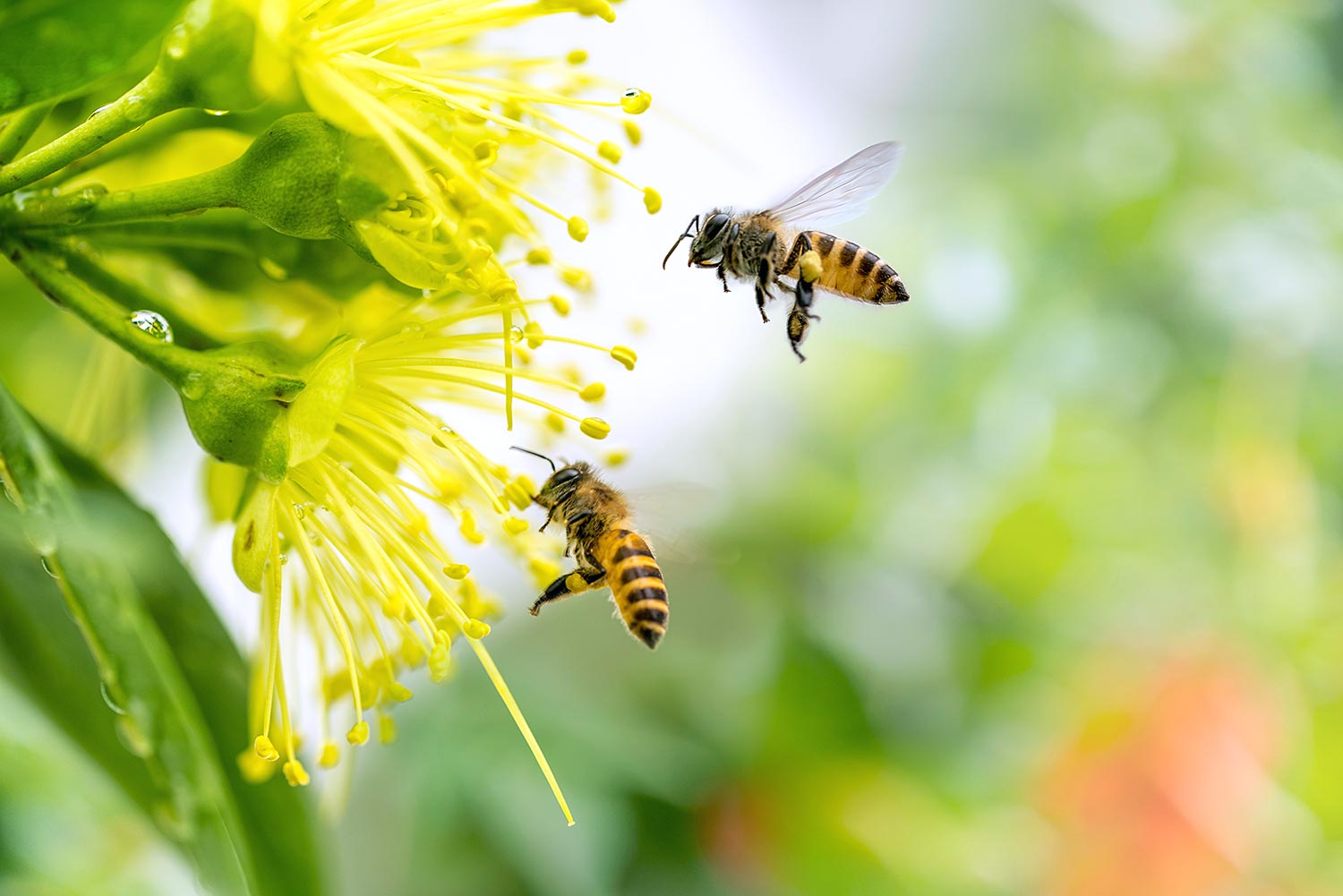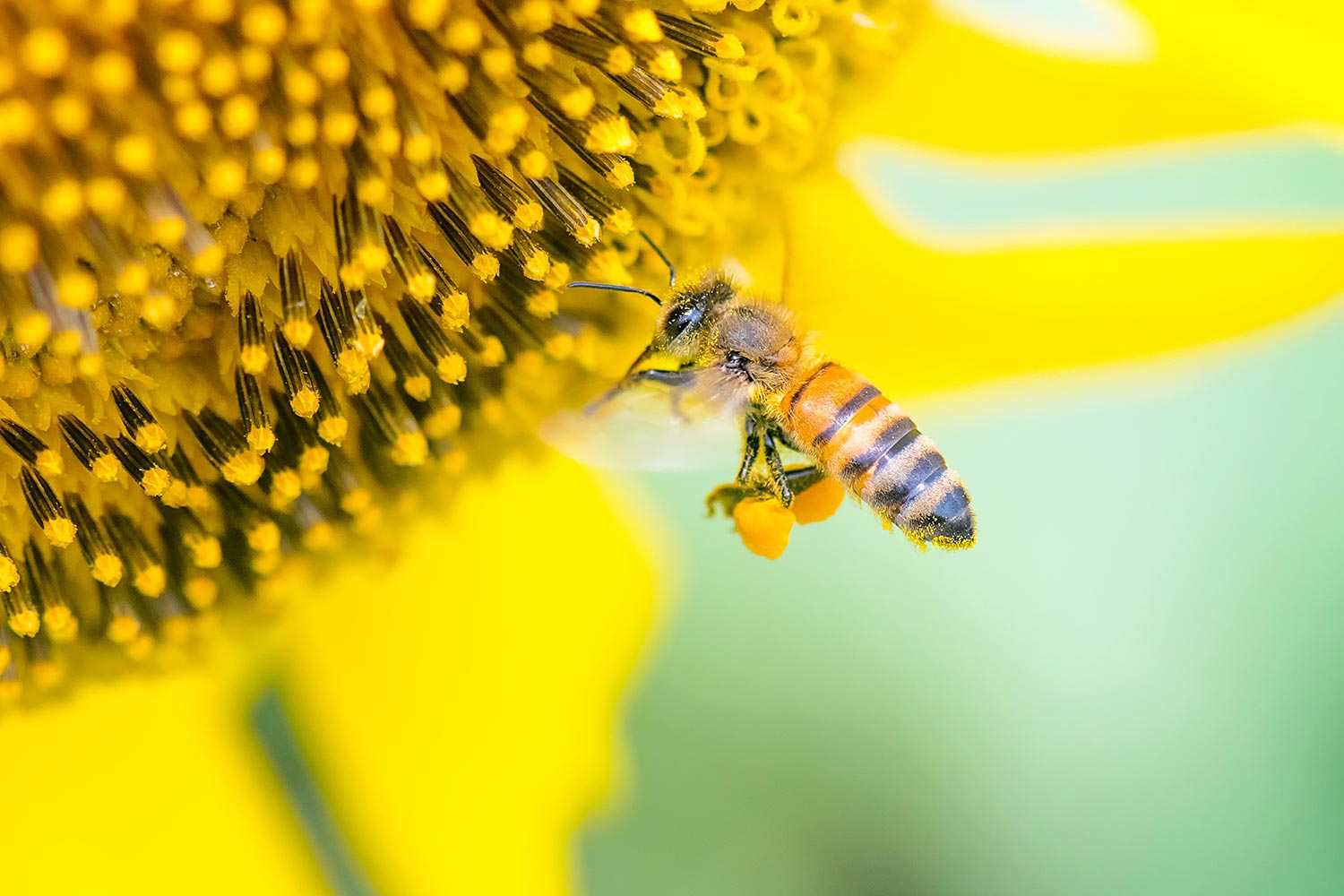
“If the bees become extinct, humans too will go extinct within four years.”
This is a famous quote usually attributed to Albert Einstein. The honey bee is known as a beneficial insect that collects honey. This yellow-and-brown striped insect has a stinger and so it may not be easy for you to come close to it. What is this little creature, that it is closely related to the survival of mankind?
Honey bees live in a hexagonal honeycomb. Generally, a colony consists of one queen bee and tens of thousands of other bees, most of which are worker bees that are female. Worker bees do almost all important jobs; they gather food such as honey and pollen, build comb cells, feed their larvae, and guard their hive from foragers. Drones, which are male honey bees, are only needed for a queen to mate with and lay eggs, and so when there is not enough food in the beehive, they get kicked out by worker bees. A queen bee is of a greater size; it gets born from a fertilized egg just like other female worker bees, but it becomes queen by eating royal jelly1 throughout its larval stage.
1. Royal jelly: a white nutritional liquid secreted from the glands in the hypopharynx of worker bees to feed larvae that are going to be queen bees. As a natural unsaturated fatty acid, it has anti-cancer effect.
A queen lays up to 2,000 eggs per day. When the queen bee is no longer able to produce enough eggs, worker bees notice it instinctively and raise a new queen bee to maintain their hive. When a new queen is enthroned, the old queen lingers on a little while and then is ousted. At this point, a swarm of worker bees protect the old queen and follow her to search for a new residence; by this, the colony gets divided.
If honey bees go extinct on the earth, first of all, we will be unable to eat honey. Honey is a sweetener that honey bees make by collecting the nectar out of flowers. For a long time, it has been regarded as precious natural food and medicine. Containing much glucose, fructose, and moisture, it is so digestible and highly nutritional. About 10–13 kg (22–28 lb) of honey is collected from a colony where one queen bee lives.
Royal jelly is used as a dietary supplement for humans and an ingredient for medicine-like products as well. Propolis2 (bee glue) is consumed as a health supplement and also used in some cosmetics and toothpastes. When you get a sting, the spot gets swollen and itchy. In some countries, they use this apitoxin to treat arthritis. In Korea, they continually develop alternative medicine such as acne treatments with honey bee venom.
2. Propolis: a resinous mixture that honey bees collect from tree buds, sap flows, or other botanical sources

In 2013, the Rural Development Administration in Korea has discovered 36 microorganisms—10 kinds of Lactobacillales and 24 kinds of Proteobacteria, in the intestines of bees. Pyrosequencing is a method of determining the order of nucleotides in DNA. It is more precise than culturing existing bacteria and using identification3. Bifidobacterium, which are probiotics identified from honey bees, exert a range of beneficial health effects such as producing antibiotics, modulating immune responses, repressing cancer, and producing vitamins. Lactococcus lactis, which is extensively used in the production of buttermilk and cheese, is found only from a certain kind of bees. For this, many studies on successful honey bee raising, prevention of honey bee diseases, and development of beneficial microbiological agents are expected to accelerate.
3. Identification (in biology): the process of assigning a pre-existing taxon name to an individual organism on the basis of natural individualistic features
Another important job that honey bees do besides providing food and medicine is pollination. Pollinating a plant means fertilizing by delivering the pollen of stamens to pistils. Most of plants bear fruit and seeds through pollination, and there are various ways of pollination: hydrophily (when pollen is distributed by the flow of waters), ornithophily (by birds), anemophily (by wind), and entomophily (by insects). 40% of plants are entomophilous flowers, and 80% of them are pollinated by bees. To harvest 1 kg (2.2 lb) of honey, honey bees search for about 5.6 million flowers. The distance they fly is equivalent to circling the earth. While these diligent bees fly every day from this flower to that flower, looking for honey, plants produce fruit and spread their offspring.
At the farms where one kind of crop such as almond, carrot, and onion is cultivated on a large scale, pollination must be finished within a short period of time. However, it is almost impossible to do by human hands, and thus honey bees are required desperately. Moreover, when plants are pollinated by bees, they produce more delicious fruits than when they are artificially pollinated. In countries like Korea where there are four distinctive seasons, they grow strawberries, cherry tomatoes, bell peppers, and so on, even in winter at greenhouses, where they need more honey bees to pollinate their crops. To do so, they sometimes import bumblebees from foreign countries because they survive winter better than Korean native honey bees do. An experiment is also conducted to preserve mated carpenter bees at a low temperature and to wake them up according to the need.

Honey bees—little, diligent workers that play an important role in the ecosystem of the earth—are reported frequently in the media that they decrease in number worldwide. At an almond farm in Florida, U.S., the honey bees which were placed to pollinate disappeared suddenly in 2006. There was a great loss in the U.S. in 2007; 25% of the whole beekeeping houses were closed and 30% of the whole honey beehives in the nation decreased by 30%. Similar symptoms were reported consecutively in Australia, Brazil, Canada, China, European countries, and African countries. The loss of a bee colony is called Colony Collapse Disorder (CCD)4. In Korea, about 76.7% of honey bees were killed by sacbrood virus5 in 2010, but the cure for this virus is unavailable until now. As the damage gets more serious year by year, it seems more difficult to harvest honey from native bees in the nation.
4. Colony Collapse Disorder (CCD): a phenomenon involving the abrupt disappearance of worker bees in a beehive or Western honey bee colony
5. Sacbrood virus: a virus that infects the larvae of honeybee, resulting in failure to pupate and death. Infected larvae change in color from pearly white to pale yellow and begin to dry out; they turn to dark brown and eventually die. When larvae die, worker bees uncap the cells to dispose of them. In the end, the worker bees too decrease and the beehive is left empty a few months later.
As CCD poses a serious threat to agriculture as a whole, the experts in entomology, microbiology, chemistry, and physics from the U.S. Department of Agriculture (USDA) investigate to figure out what causes it. As a result, many possible causes have been proposed: climate change, electromagnetic waves, chemical pollutants, pesticides, Israeli Acute Paralysis Virus (IAPV), and so on. The University of Montana honeybee researchers suspect that insect iridescent viruses and the fungus called Nosema ceranae cause CCD. Although there are many assumptions, however, what ultimately causes CCD is not clear until now. In his book Fruitless Fall: The Collapse of the Honey Bee and the Coming Agricultural Crisis, Rowan Jacobsen warns that the extinction of the insects that pollinate plants will impact not only on beekeeping but also on farming in general, and also laments for helplessness of men who cannot discover the cause of this new illness that has come upon them like a disaster.
What will happen to mankind if honey bees disappear? Whatever the reason, if there are no more these diligent workers that enable the production of various food such as fruit and seed, man will have to pay a tremendous amount of efforts and money to secure food. The United Nations Environment Program (UNEP) warns that tens of thousands species of plants may become extinct in the near future unless we hurriedly protect the environment, and urges that the number of honey bees must be increased so that we can maintain enough pollination of critical crops.
As Einstein warned, if the balance of pollination breaks up by the decrease or the extinction of honey bees, we will be faced with extreme food shortage and the destruction of the entire ecosystem of the earth in the end. Under the excuse of pursuing an affluent and convenient life along with economic development, mankind has disrupted the order of the ecosystem created by God. Now, it is terribly worrisome that the survival of mankind is threatened as the damage boomerangs. Nature is created according to God’s will and there is nothing unimportant in it.
- Sources
- Rowan Jacobsen, Fruitless Fall: The Collapse of the Honey Bee and the Coming Agricultural Crisis, Bloomsbury USA, 2009
- UNEP Emerging Issues: Global Honey Bee Colony Disorder and Other Threats to Insect Pollinators, 2010